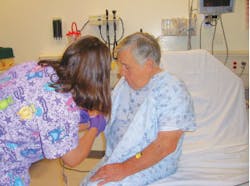The last decade has
seen a rapid rise in the discovery and commercialization of new
technologies and new detection platforms, the combination of which has
spawned an entirely new generation of point-of-care devices. But that is
history repeating itself. For the past 50 years, advances in technology
have opened new markets by making the testing better, simpler, and
faster. Perhaps now we should also add “closer” as in closer to the
patient.
The question is, as new technologies allow us to
move the testing “closer” to the patient, is that necessarily better?
The answer depends on what you are testing for; in some cases, the
answer is yes; in others, no; and, in many cases, the answer is still
maybe.
When is value gained?
Technology breakthroughs have produced
devices that can be used by the patients themselves — the ultimate
in point-of-care testing. Examples are home pregnancy tests, glucose
monitoring, and even limited drug screening. But these applications
are necessarily limited because more complex testing requires
medical knowledge and interpretation. For example, tests that the
healthcare industry considers simple, like a urinalysis, are beyond
the interpretation of the average patient for home use.
Just because we can manufacture a device simple
enough and foolproof enough for a patient to use does not mean we
should. Point-of-care testing needs to be evaluated in light of medical
benefit. For example, what value would be gained from a patient
performing a thyroid hormone test? Today, technology has made that a
simple test; and there is no doubt that we could develop a simple and
automated device to perform the test from a finger stick blood sample.
But what is to be gained?
Who would interpret the result? Even if the
patient is determined to be hypothyroid, a physician must prescribe
replacement therapy. Is there value in monitoring that therapy? Probably
not. This is a case where my answer to whether point-of-care testing
would be necessary is “no.” On the other hand, we all know the benefit
of emergency room point-of-care testing for BNP (brain natriuretic
peptide). Technology breakthroughs, regardless of how easy they are to
perform, have limits defined by medical benefit and the patient's
ability to act on the information provided.
A 50-year trend continues
With that in mind, today virtually all of the
major diagnostic companies provide doctor's-office systems capable
of performing basic chemistry, hematology, serology; and limited
microbiology testing. Legislation preventing federal program
reimbursement for self-referral, however, has hampered growth in the
sector. Still multiphysician clinics that operate CLIA-licensed
laboratories can perform a stout menu of meaningful tests, including
thyroid hormone, while the patient is in the examining room. In this
point-of-care situation, a thyroid hormone result can be beneficial
to patient care, both in terms of immediacy of action and prevention
of repeat visits and/or referrals.
This is a historical trend that has been observed
over the past 50 years, and it will inevitably continue. As technology
advances to simplify and automate tests previously performed only in
reference labs, diagnostic providers are creating platforms that open
these tests up for performance by hospital labs and clinics.
Medical value of tests at POC
An excellent example is Cepheid's recent
introduction of the GeneXpert for MRSA (methicillin-resistant
Staphylococcus aureus) testing. Only 10% of the nation's hospitals
are licensed for PCR-based testing. Yet, Cepheid's MRSA test uses
real-time PCR for detection. By incorporating all of the PCR
complexity inside the GeneXpert, Cepheid succeeded in getting Food
and Drug Administration waived status for the MRSA molecular
signature test for use by all hospitals.
meaningful test result at a time that will influence medical action.
Cepheid's success is more than just simplifying a
difficult test. It is the medical value of the test at the
point-of-care. Reports indicate that 62% of hospital-acquired infections
are due to MRSA. Considering the 18% death rate associated with
infection, hospitals need to know if the infection is MRSA in order to
treat appropriately. If the test is sent to a reference laboratory for
testing, the turnaround time is typically three to four days. With the
GeneXpert, the result is available in a matter of hours and at a time
when the attending physician can take the appropriate action.
This is the real value of point-of-care testing;
providing a meaningful test result at a time that will influence medical
action. Today, because of the death rate associated with MRSA, if a
physician suspects MRSA and the definitive result is three to four days
away, they have no choice but to treat as though the infection was MRSA
until they receive the result. An indiscriminant use of antibiotics is
what has led to a rise in antibiotic resistance and is a waste of
healthcare dollars.
Simplifying future testing
The future of testing will be the combination
of simplification with medical need at the point-of-care in a time
frame where the result affects medical intervention. There are
several other tests that are likely to receive broad scale adoption.
Clostridium difficile is a continuing problem in long-term care
facilities, yet none of the staff is licensed to perform such
testing at the point-of-care. Testing certain strains of HPV (human
papilloma virus) that are 100% correlated to cervical cancer would
be of great value in clinics.
Diagnostic companies will continue working to
simplify testing to open their products to a broader audience that can
perform tests closer to the point-of-care. BNP and MRSA are two examples
of tests that should be performed at the point-of-care, thyroid hormone
is an example of one that is not. Others like cancer markers, HPV,
hepatitis C virus, and human immunodeficiency virus are still being
tested for validated use at the point-of-care. As technology continues
to advance, these may very well become the next tests available broadly
at the point-of-care.
Randy White, PhD, CEO
of Adnavance Technologies Inc., in San Diego, CA joined the company in
mid-2007. Dr. White began his career as a laboratory director for
National Health Laboratories.


